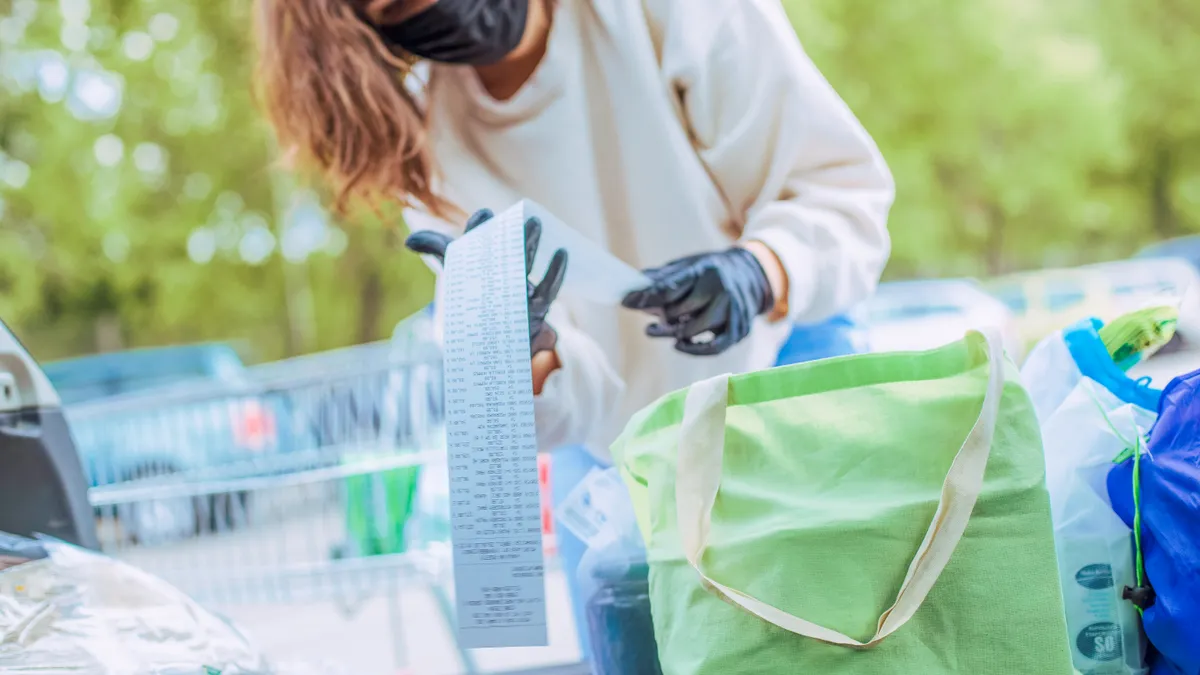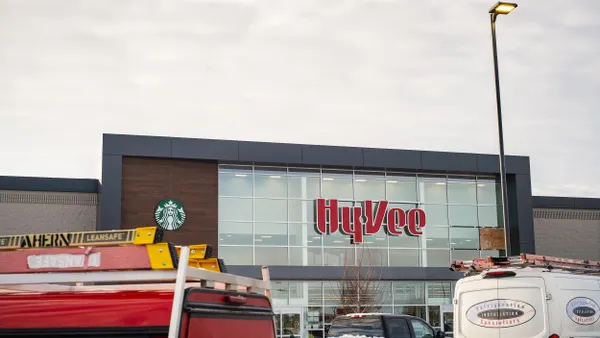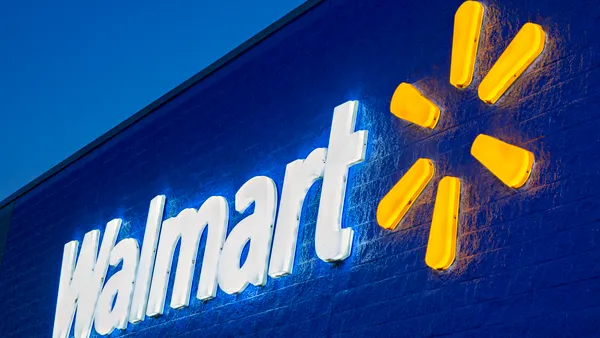This story is the second in a series on key trends that will impact grocers in 2022.
The delivery landscape is changing rapidly, and last year saw grocers modify delivery fees and order minimums as a result.
The most notable shift was Whole Foods Market's announcement last fall that it would do away with free two-hour delivery for Amazon Prime members and institute a nationwide $9.95 delivery fee.
The move prompted outrage among many shoppers. Within industry circles, however, the move has sparked debate over how to make e-commerce profitable — a top concern for grocers — while also catering to the needs of online shoppers. Although the specialty grocer's steep and sudden fee hike makes it an anomaly so far in the industry, it underscores the rapid changes in consumer demand and the need to bring fees in line with new services.
Consumers in a growing number of markets can now choose in-home service, instant-needs delivery in under 30 minutes and less expensive next-day delivery. As the pandemic continues to influence demand, the U.S. population over 65 continues to grow and young, digital-savvy consumers gain spending power, the need to offer a variety of services, along with the fee structures and promotions to support them, is increasing.
Lower or no fees and order minimums can boost customer acquisition and make online shopping more accessible financially to shoppers, while higher ones can help cover the costs of picking and delivering orders while also encouraging bigger baskets. Meanwhile, subscriptions, which often promise lower or no delivery fees, can serve to lock in shopper loyalty, but run the risk of alienating customers who don’t plan to be frequent shoppers.
Experts said they expect — and encourage — grocers to continue testing strategies for dealing with delivery costs.
"Right now, it's all an experimentation game," said Anne Mezzenga, a Target veteran and co-CEO of retail blog Omni Talk. "I think all every retailer is trying different levers. … to eventually make this more scalable, more profitable.”
Grocery Dive talked to several experts who weighed in on the factors grocers can consider when determining order fees and minimums, and how they can leverage them for different desired outcomes.
1. Speedier service as a premium
The rise of instant needs companies in the U.S. is pushing grocers toward faster delivery service and also challenging the traditional retail strategy of speedier service equating to higher fees. Some instant-needs startups operating in major cities have no order minimums or delivery fees. The largest player in the emerging channel, Gopuff, charges a delivery fee of just under $2.
But given the volatility and challenging economics of this business, industry observers don't expect grocers and third-party marketplaces to follow suit, though fees and minimums will still need to be competitive. Mezzenga expects 30 minutes to be the threshold for grocers to charge for speedy delivery as a premium service.
Kroger Delivery Now, the 30-minute convenience delivery service powered by Instacart that launched in September, for one, charges a $2.99 fee and carries a $10 minimum.
While younger shoppers are coming to expect instant delivery, online shopping is becoming fragmented and faster service warrants premium fees, said Wendy Liebmann, CEO and Chief Shopper of WSL Strategic Retail. Higher fees for convenience delivery could prompt shoppers to switch to a delivery subscription to save money and stay stocked up on essential items, like diapers, while locking in loyalty for companies, Liebmann noted.
2. Lower fees to influence shopper behavior
Wanting faster service doesn’t necessarily mean customers will pay the premium for speedy delivery, unless the item is a necessity.
Low or no delivery fees are more compelling to grocery shoppers than choosing the fastest option in deciding where to shop for same-day or faster delivery service, Coresight Research recently found. In its consumer survey released in October, 60.6% of respondents picked low or no fees as the factor most important to them — placing it above pricing (53.4%), availability (49%), quality (45.2%) and choice (43.3%) of products. Only 40.4% of respondents said getting the fastest delivery option is their priority.
Grocers can use the attractiveness of low or no fees to influence shopper behavior. Retailers often leverage free delivery as a promotional tool around specific events, like during the holiday season, to help manage sales volumes, Dennis Moon, chief operating officer at delivery platform Roadie, wrote in an email. Many grocers also offer free or lower-fee delivery to attract new customers.
Giant Food recently reduced its delivery fees and minimums and added lower-priced weekday service. The changes incentivize customers to use its Giant Delivers service and get deliveries on days that were less busy for workers, said Gregg Dorazio, who heads up e-commerce for the grocer. The grocer has also worked with CPGs to offer delivery promotions when customers buy a certain amount of products from the brands, Dorazio said.
So far, customers have responded the way Giant Foods hoped they would: “Tuesdays have now become as popular as Sundays in terms of delivery windows," Dorazio said.
3. Make operations more efficient
To lower the costs of delivery operations and fees passed onto consumers in the long-term, sources recommended grocers invest in technologies now to improve operational efficiencies.
Batching orders is one way grocers can make delivery more financially viable, said Mezzenga and Tom Fiorita, founder and CEO of gig worker delivery company Point Pickup.
Increasing the number of deliveries by a single person improves not only delivery costs for companies but also per hour labor for workers, since they'll be able to earn more tips in less time, Fiorita said, noting grocers can invest in cold chain technologies, like environmentally friendly cooler packaging, that let drivers deliver more orders.
Ethnic e-grocer Weee has said its next-day delivery service, which is free for orders over $35, allows for improved efficiencies, like being able to deliver a higher number of orders per day and combine separate orders from a customer into one delivery.
Automation is another area grocers can explore to improve efficiencies. While technologies like micro-fulfillment centers can be expensive upfront, Mezzenga sees long-term payoff: "That investment in one micro-fulfillment center that can serve online orders for 15 stores and maybe even some of the fresh produce that just needs to be picked, there are huge advantages in that and I'm surprised that retailers have been so reluctant to make that investment already."
4. Incentivize bigger baskets
Whole Foods' fee hike last year sparked industry chatter about how grocers can pass delivery costs to customers and drive bigger baskets.
At the time the fee was announced, a Whole Foods spokesperson noted that "average basket sizes have continued to increase since the beginning of 2021" and said customers keep using delivery to stock up on groceries.
The specialty grocer, which differentiates itself with a product selection that already comes at a higher price point, can potentially benefit from a higher fee, said Carol Spieckerman, president and CEO of Spieckerman Retail.
"Charging a fairly nominal fee like $9.95 can actually have the effect of encouraging larger basket size because it becomes, 'Well, while I'm there and since I'm already paying this flat fee, I'll just load up.' … I think that's a really good model for for Whole Foods," she said.
Retailers like Whole Foods that have the "one-two punch" of loyalty and price-resistant shoppers are better positioned to charge fees than discounters with a price-sensitive consumer base, Spieckerman said.
Other grocers will likely find $10 hard to sell to shoppers. If grocers need $10 or more per order to cover delivery costs, Mezzenga instead recommends they explore other areas to generate revenue, like a subscription model or retail media networks.
To drive bigger baskets, Harris Teeter took the opposite approach with the tiered service fee structure it rolled out last year for its ExpressLane service. The grocer has a $25 order minimum, except for subscription members, and charges a $4.95 fee for orders between $25-$49.99. The fee gets lowered to $2.95 for orders between $50 and $100.
5. Experiment with subscriptions
Subscriptions with a monthly or annual fee for unlimited delivery are becoming more common, Moon of Roadie said. Several grocers, including Albertsons, Kroger and Ahold Delhaize, have recently launched offerings that bundle no-fee delivery with other perks like bonus fuel points and product savings. .
"When you have people locked into a subscription model, you really have them locked into your ecosystem. They'll look for excuses to shop with you and it will be an exception to look around," Spieckerman said.
Large retailers with broad assortments, like Amazon and Walmart, and marketplaces are better positioned to offer subscriptions, sources said. Spieckerman said it can be harder for grocers to convience consumers to add yet another subscription service to their lives, unless they have high customer loyalty or can lean into superior quality of produce to justify subscriptions.
"There's a real danger of shoppers saying, 'Well how many of these subscriptions do I want to pay for?'” she said. Other experts have raised concerns that grocers' subscription programs don't offer enough perks to make them valuable.
6. Consider vulnerable shoppers
The exploding availability of online shopping for SNAP recipients last year and financial hardships brought on by the pandemic have brought more attention on shoppers facing financial obstacles. Testing of online purchasing for the Special Supplemental Nutrition Program for Women, Infants and Children (WIC) has just started as the federal government looks to modernize redemption of WIC benefits.
Retailers face decisions over whether or not to waive or reduce fees or order minimums for shoppers receiving government assistance to help pay for their groceries.
For example, Amazon offers reduced pricing on its Prime subscription for students and for EBT and select government assistance recipients. Shoppers using SNAP funds don't need to be Prime members to shop Amazon Fresh. The Giant Company and Giant Food waive order minimums for pickup and delivery for customers using SNAP funds to their orders.
In looking to incentivize older people to turn to e-commerce, Harris Teeter waived its service fee for customers ages 60 and older and lowered delivery to $4.95 on Thursdays from 9 a.m. to 2 p.m.
7. Offer transparency to consumers
As grocers continue to experiment with fees, they face challenge of determining how much to information to share with customers so they aren't surprised when they go to checkout, sources said.
Flat fees, while straightforward to customers, can leave grocers without room to tweak costs and spark backlash from customers when raised. Variable fees can provide more flexibility but can leave customers confused if they are not clearly explained, potentially leading to diminishing returns, Spieckerman said.
“If it becomes too complex and too convoluted, you risk alienating shoppers, because especially for something like delivery, they really want it to be straightforward, easy to understand and easy to execute," Spieckerman said.
One option to bypass the problem of determining fees and order minimums is to instead build the costs of e-commerce operations into product pricing, she said. De-coupling online prices from and in-store can work as long as category pricing is competitive, Jordan Berke, founder and CEO of Tomorrow Retail Consulting, wrote on LinkedIn.
Fiorita of Point Pickup, which has grocery delivery comprising 63% of its business, said he is seeing some grocers following in the footsteps of third-party marketplace models, which can increase product prices between 20% to 30%, by raising some prices while promoting lower fees and better service through their own e-commerce platforms.
While it's understandable companies won't give away the exact algorithms with how they determine fees, some public-facing insight can let shoppers know what to expect, sources said.
"More transparency is generally better, but most importantly, customers hate to see surprise fees at the point of sale," Moon of Roadie said. "Hidden fees or surcharges at checkout can cost you a sale, and sometimes a customer."
8. Provide a range of options
From faster but pricier service to lower-priced but slower delivery, grocers will want to have a range of options to meet different consumer needs, sources said.
Spieckerman broke delivery into three main categories: stock-up, urgent and the in-between shop for items customers need but not instantly.
"The same shopper will make different decisions for different purchases, and smart retailers will offer them choices. It’s all about offering that optionality," said Moon.
While order minimums for free delivery aim to justify the cost of delivery for the retailer, Moon said he doesn't see a need for the grocer to add an order minimum if it's already going to charge a fee.
"[If] you’re charging the customer a fee for delivery, there’s really no reason to create limitations for that customer on what they can, can’t or have to buy," Moon said. "If your customer wants to get a week’s worth of groceries, great. If they’re really just craving pizza bagels and don’t want to leave their house to get them, that’s also great."












